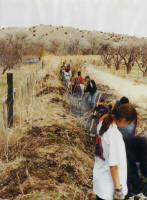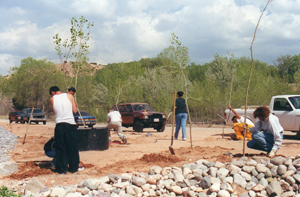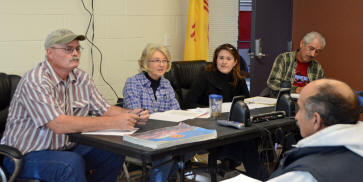Acequia de La Puebla
El Agua es Vida
About the La Acequia de la Puebla
 For
generations the people of La Puebla have cared for and maintained their
acequias. A 1781 census from La Iglesia de Santa Cruz de la Canada lists
25 residents living in the plaza known as San Cristobal de la Puebla. In
those early years irrigation was a matter of life or death, for the
sacred waters brought life to the community. Today irrigation water is a
matter of cultural survival, historical preservation, and a tradition
that is passed on to future generations. Care of the acequia madre also
brings unity and cooperation to the community. The term acequia is
derived from the Arabic word saqa which means “to water.” Later the word
evolved to al saqiya which refers to an irrigation ditch. The Pueblo
people maintained and used irrigation techniques in their culture as
well. When the Spanish brought the term la acequia and the Old World
techniques of irrigation to Nuevo Mexico they merged with the Pueblo
irrigation practices to create an Indo-Hispano tradition known today as
acequia culture. This important culture has survived in La Puebla for
centuries and is still in practice today.
For
generations the people of La Puebla have cared for and maintained their
acequias. A 1781 census from La Iglesia de Santa Cruz de la Canada lists
25 residents living in the plaza known as San Cristobal de la Puebla. In
those early years irrigation was a matter of life or death, for the
sacred waters brought life to the community. Today irrigation water is a
matter of cultural survival, historical preservation, and a tradition
that is passed on to future generations. Care of the acequia madre also
brings unity and cooperation to the community. The term acequia is
derived from the Arabic word saqa which means “to water.” Later the word
evolved to al saqiya which refers to an irrigation ditch. The Pueblo
people maintained and used irrigation techniques in their culture as
well. When the Spanish brought the term la acequia and the Old World
techniques of irrigation to Nuevo Mexico they merged with the Pueblo
irrigation practices to create an Indo-Hispano tradition known today as
acequia culture. This important culture has survived in La Puebla for
centuries and is still in practice today.
Four Acequias
 The three ditches of La Acequia de la Puebla
cover approximately ten miles. In December, the Commission (the governing
body of the acequia association) and the Mayordomo (caretaker) are
elected. Derechos de agua are the water rights retained by the
parciantes of the acequia association. Parciante refers to the
partitioning of land and water rights that accompanies the ownership of
that land. Parciantes must pay a cuota (fixed fee) annually to the
acequia association to use the water and to benefit from the irrigation
system. Similar to membership dues, the money collected by the
Commission is used for maintenance, repairs, and other expenses the
acequia system may incur. It is the responsibility of each parciante to
pay the fee each year and to help clean the acequia in the spring. Other
reglas (rules) for repartimiento de agua (distribution of water) govern
the acequia members and can be found in the By-Laws and in Michie’s
Annotated Statues of New Mexico, Chapter 72, Water Law.
The three ditches of La Acequia de la Puebla
cover approximately ten miles. In December, the Commission (the governing
body of the acequia association) and the Mayordomo (caretaker) are
elected. Derechos de agua are the water rights retained by the
parciantes of the acequia association. Parciante refers to the
partitioning of land and water rights that accompanies the ownership of
that land. Parciantes must pay a cuota (fixed fee) annually to the
acequia association to use the water and to benefit from the irrigation
system. Similar to membership dues, the money collected by the
Commission is used for maintenance, repairs, and other expenses the
acequia system may incur. It is the responsibility of each parciante to
pay the fee each year and to help clean the acequia in the spring. Other
reglas (rules) for repartimiento de agua (distribution of water) govern
the acequia members and can be found in the By-Laws and in Michie’s
Annotated Statues of New Mexico, Chapter 72, Water Law.
The Acequia de la Puebla, is the life blood of the community and it is made up of many different components which date back for centuries. The presa (dam) diverts water from the Santa Cruz River into the acequia madre. A desague is a small channel or outlet used to drain excess water, sand, and debris from the main channel. These sand traps are built into the main channel and are used to clear the waters for irrigation following a storm. In los anos pasados, a canoa (flume) made from logs was used to channel water across arroyos. Today these have been replaced by canos or steel culverts. The bordo is the dirt embankment which runs along the side of the acequia. These embankments protect the main channel from flooding and runoff during heavy rain storms and snow melt. An ancon is a stone retaining wall used along land contours and serving as a terrace to contain the irrigation water.
The challenge today, for the Commissioners, parciantes, and Mayordomo of La Acequia de la Puebla is to preserve these centuries old traditions and incorporate these important lifeways into modern day practices of irrigation and agricultural techniques. This traditional knowledge will guide future generations of parciantes in the future and preserve la tierra bendita y l’agua sagrada for the La Puebla community in the 21st century.
Annual Meeting
The last Annual Meeting was held on December 14, 2013. The picture to the left shows our current Commissioners and Mayordomo who were all re-elected for a new 2 year term
 Our
annual meeting is held each year in December. This is a requirement of
the Acequia Bylaws. Elections for Commissioners and Mayordomo are held
in the odd numbered years.
Our
annual meeting is held each year in December. This is a requirement of
the Acequia Bylaws. Elections for Commissioners and Mayordomo are held
in the odd numbered years.
Congratulations to all and thanks for your service.
Purpose
The Purpose of Acequia de La Puebla is to:1) promote the agricultural uses of water on the lands served by the Acequia,
2) promote the efficient and beneficial use of water,
3) sustain customs and traditions of providing water to parciantes in a manner that is fair an equitable,
4) protect and defend the rights and interests of the Acequia and the parciantes,
5) maintain the infrastructure and easements of the Acequia de La Puebla, and
6) maintain an adequate diversion right to ensure a sufficient water supply for parciantes.
The acequia is served by three volunteer Commissioners and one Mayordomo.
(Bylaws, Art 1, § 1). The New Mexico State Engineer’s Office recognized Acequia de La Puebla in 1659 (Bylaws, Art 1, § 3).
Mission
Water is the lifeblood of our communities. The parciantes of Acequia de La Puebla believe that water should be protected as a community resource so that future generations can grow food and can have a healthy and secure source of water for needs within the community. We seek to promote agriculture by preventing the severance of water rights from irrigated land. We honor the ancient customs and traditions embodied in our Acequia and seek to govern our Acequia to continue the connection between our land, water and culture in perpetuity.
Special thanks to La Puebla's own Michael Miller for all the great historical information on this page. Mike is a writer and poet. He is the retired Director of Research and Literary Arts at the National Hispanic Cultural Center of New Mexico.